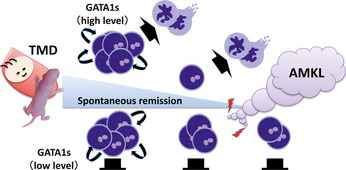Figure 4.

Multi‐step leukemogenesis caused by a structural mutation in the GATA1 protein. Because the contribution of the GATA1‐S mutation to the hyper‐proliferative phenotype of megakaryocytes is restricted to fetal hematopoiesis, the phenotypes observed in babies with Down syndrome with transient myeloproliferative disorder (DS‐TMD) and mice rescued with GATA1‐S disappear spontaneously. At high levels of expression, GATA1‐S has the potential to stimulate megakaryocytic differentiation and rapidly eliminate accumulated abnormal megakaryocytic progenitor cells. However, a low level of GATA1‐S fails to promote differentiation and instead extends the life spans of those progenitor cells bearing the GATA1‐S mutation. Consequently, those cells have an opportunity to acquire additional genetic hit(s) and eventually transform into a leukemic cell.
